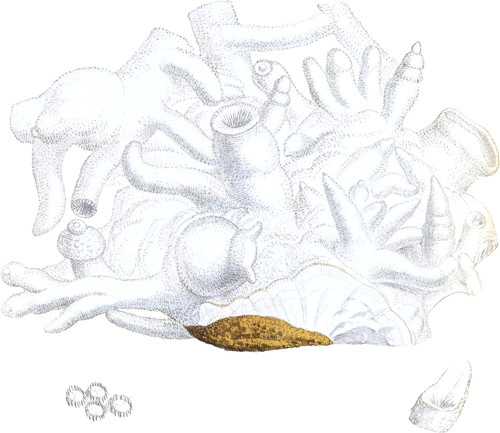 Enlarge
Enlarge
British Mineralogy
Hard Carbonate of Lime
- Div. 2. Imitative.
The elegant specimens of Hard Carbonate of Lime from Eizenarzt in Styria have long been recognised under the misleading name of Flos-ferri. The no less elegant specimens of our isle lately discovered at Dufton in Lancashire are, if possible, more truly interesting to us, as a product of our own country, rich not only in the conveniencies of life, but in materials for that sort of instruction which teaches the ways of Providence, so that we cannot forget to adore the infinite wisdom which even provides for our curiosity, and thus proves an incitement to knowledge of the first utility. In this fossil we see so much of the vegetable, and even of the animal structure, that our astonishment is heightened beyond all common sensation.
The substance is a stone, though its formation is like that of a plant or animal. The Agaricus tubiformis—see English Fungi, tab. 382—or its variety, Ramaria ceratoides, often has as little resemblance to vegetation as this; and the Splæria digitala—English Fungi, tab. 69—shows, when broken, very nearly the same conical and fibrous surface, or fracture, as this stone, as I have endeavoured to express, besides other analogies, whilst the coralliform appearance or structure of it has been universally acknowledged. The specimens I possess are so large and elegantly formed, that they ought to be seen for any one to get a just idea of them*: but to proceed with the description as well as I may. It is very compact, with a partly conchoidal and somewhat splintery fracture; and more or less composed of fibres radiating from the axis with an inclination towards the ends of the branches, without any sign of the usual rhomboidal fracture of Carbonate of Lime. This texture continues throughout the whole formation, whether globular, curving, branching, or inosculating. The centre is generally most dense and opaque, and the outside opens into spiculæ—see the right hand figure;—other fresh spiculæ seem to be emerged as it were, and form a covering. Sometimes the outward spicule are very transparent, giving a velvety appearance in particular lights. Sometimes there are small grains of the equiaxed form of common Carbonate of Lime upon the surface, giving it a curious appearance—see the lower left hand figure.
Its gravity and hardness help to distinguish it. Probably its density may answer for these characters, as it effervesces with acids, and is dissolved very readily, like other Carbonates of Lime. The variety figured on the last plate will often form one specimen with this.
- * Mr. Soiverby will most willingly show them to his friends, on the first or third Tuesday in the succeeding months of the year.

